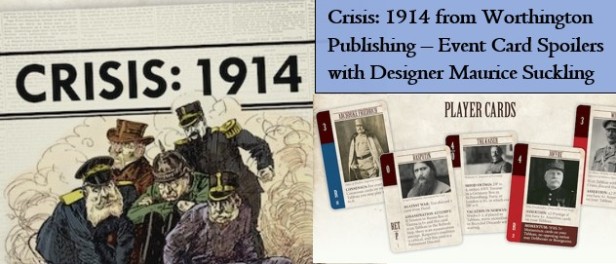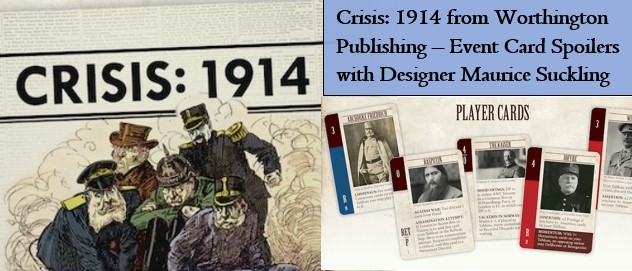We became acquainted with Maurice Suckling with his game Freeman’s Farm 1777 from Worthington Publishing in 2019 and really enjoyed the mechanics and how they all came together to create an interactive and interesting look at the Battle of Saratoga during the American Revolution. Since that time, Maurice has designed several other games that have went on to successful Kickstarter campaigns including Hidden Strike: American Revolution, Chancellorsville 1863 and 1565 Siege of Malta. He is now working on a game that is tied to the buildup of tensions that led to the outbreak of The Great War called Crisis: 1914 from Worthington Publishing, which was successfully funded on Kickstarter this past summer. He has prepared a series of Event Card Spoilers for the game and we are hosting them here on the blog. These posts will share the cards basis in history as well as how they are used in the game.

If you are interested in ordering Crisis: 1914, you can pre-order a copy for $65.00 from the Worthington Publishing website at the following link: https://www.worthingtonpublishing.com/collection/crisis-1914-pre-order-this-game-will-not-ship-until-february-2024
Card #8 – No Italian Support

Despite its position as a formal member of the Triple Alliance from 1882, Italy was reluctant to provide its support to Austria-Hungary (and Germany) during the crisis. Rome – and Italians, more broadly – viewed Austria-Hungary warily, not least because of existing claims to the Tyrol and the multi-ethnic port city of Trieste (Raicer 2009, 15; Martel 2014, 90). During the crisis, Berlin repeatedly urged Berchtold to secure Italian support, but he was ultimately unsuccessful (Martel 2014, 186); Count Tisza even noted on July 21 that Italian intervention against the dual monarchy could not be discounted (McMeekin 2013, 139). This fear would eventually prove to be well-founded: in May 1915, enticed by the Triple Entente’s promises of the aforementioned territories, Italy joined the war against its former allies (The National WWI Museum and Memorial n.d.).

Card #11 – Assassination Investigations
After his capture, the Serbian assassin Gavrilo Princip confessed to belonging to the Black Hand organization and was part of a wider group involved in assassination planning (Otte 2014, 14-21). As the July Crisis was unfolding, there were ongoing investigations into the assassinations of June 28 (Martel 2014, 165). The revelations from these investigations – showing the likely, and later confirmed, complicity of high-ranking Serbian officials in the plan and ultimately culpability for the committed murders – served to amp up the Austro-Hungarian attitude toward and appetite for war, or at least served as an actionable pretext for it (Martel 2014, 168).

Card #15 – Count Alexander Hoyos – Chef de cabinet of the Foreign Minister
Although only thirty-eight by the start of the crisis, Alexander Hoyos had already acquired a reputation as a hawk through his leadership of the “Young Rebels” at the Ballhausplatz (McMeekin 2013, 89; Martel 2014, 105). As Sean McMeekin points out, Berlin was particularly well aware of his proclivity for aggressive foreign policy measures: he had previously sought German support for the annexation of Bosnia-Herzegovina during the First Bosnian Crisis of 1908-1909 (McMeekin 2013, 89). This existing relationship would ultimately benefit Austria-Hungary during the July Crisis, not least because his mission to visit the Kaiser at Potsdam proved critical in securing the Kaiser’s “Blank Cheque” (McMeekin 2013, 89-91).
Hoyos himself emphasized separately that Austria “must seize the opportunity to solve the Serbian question” and proposed (to Arthur Zimmerman) a “‘surprise attack against Serbia without prior diplomatic action’ as the ‘right modus procedendi’” (Otte 2014, 78). Still, he acknowledged that “the demands [of the ultimatum] were such ‘that no nation that still possessed self-respect and dignity could possibly accept them’” (Martel 2014, 148).

Card #21 – The Kaiser’s Blank Cheque
On July 5th, Counts Hoyos and Szőgyény met with the Kaiser in Potsdam. The Kaiser twice told the pair that he would need to consult with Bethmann Hollweg, who arrived late to the meeting. However, his tact changed at the end of the meeting and was significantly less measured. Szőgyény summarized the Kaiser’s subsequent points to Berchtold: “[Austria-Hungary’s] action against Serbia… must not be delayed. Russia’s attitude would no doubt be hostile, but to this he had been for years prepared, and should a war between Austria-Hungary and Russia be unavoidable, we might be convinced that Germany, our old faithful ally, would stand at our side. Russia at the present time was in no way prepared for war, and would think twice before it appealed to arms” (McMeekin 2013, 99). As Sean McMeekin puts it, Austria-Hungary now had the Kaiser “on the record” (McMeekin 2013, 100).
The next day, Hoyos and Szőgyény met with Bethmann Hollweg and Zimmerman, whereupon Szőgyény informed Berchtold that “the chancellor, like the kaiser, believes that immediate action on our part against Serbia offers the best and most decisive solution to our difficulties in the Balkans” (McMeekin 2013, 104).
Together, these assurances – from Wilhelm II and Bethmann Hollweg to Hoyos and Szőgyény (and, by extension, Berchtold) – represent the “blank cheque” to which historians refer. In this game, it is termed “The Kaiser’s Blank Cheque” and thus emphasizes Wilhelm’s recklessness (McMeekin 2013, 99); this is a deliberate decision to ensure that the Bethmann Hollweg player does not feel they should be able to control this card in Berchtold’s deck. As Nomikos and North argue: “The initiative to support Austria in her energetic policy toward Serbia came from the Kaiser” (Nomikos and North 1976, 37). With this in mind, the view here is that the most substantial damage (i.e., encouragement to Berchtold) was done by the Kaiser’s loose words on July 5, whereas Bethmann Hollweg displayed very little capacity to control the Kaiser throughout and before the July Crisis.
If you missed the previous entries in the series, you can catch up on the posts to date by following the below links:
Series Introduction and General Mobilization Cards
If you are interested, we posted an interview with the designer and you can read that at the following link: https://theplayersaid.com/2023/07/12/interview-with-maurice-suckling-designer-of-crisis-1914-from-worthington-publishing-currently-on-kickstarter/
-Grant
